Patients with paws Emergency vet clinic provides care, compassion to owners and pets alike
Read this article for free:
or
Already have an account? Log in here »
To continue reading, please subscribe:
Monthly Digital Subscription
$0 for the first 4 weeks*
- Enjoy unlimited reading on winnipegfreepress.com
- Read the E-Edition, our digital replica newspaper
- Access News Break, our award-winning app
- Play interactive puzzles
*No charge for 4 weeks then price increases to the regular rate of $19.00 plus GST every four weeks. Offer available to new and qualified returning subscribers only. Cancel any time.
Monthly Digital Subscription
$4.75/week*
- Enjoy unlimited reading on winnipegfreepress.com
- Read the E-Edition, our digital replica newspaper
- Access News Break, our award-winning app
- Play interactive puzzles
*Billed as $19 plus GST every four weeks. Cancel any time.
To continue reading, please subscribe:
Add Free Press access to your Brandon Sun subscription for only an additional
$1 for the first 4 weeks*
*Your next subscription payment will increase by $1.00 and you will be charged $16.99 plus GST for four weeks. After four weeks, your payment will increase to $23.99 plus GST every four weeks.
Read unlimited articles for free today:
or
Already have an account? Log in here »
Hey there, time traveller!
This article was published 06/01/2020 (2166 days ago), so information in it may no longer be current.
The Saturday overnight shift at the Winnipeg Animal Emergency Hospital on Pembina Highway is getting underway with a flurry of activity.
Beyond the waiting area and white-walled examination rooms, staff dressed in scrubs move quickly through the clinic’s narrow hallways, tending to nervous dogs and cats in metal kennels.
“Don’t you want some of this?” asks Anika Toews, offering an index finger covered in mushy dog food to an uninterested Pomeranian wearing a cone.
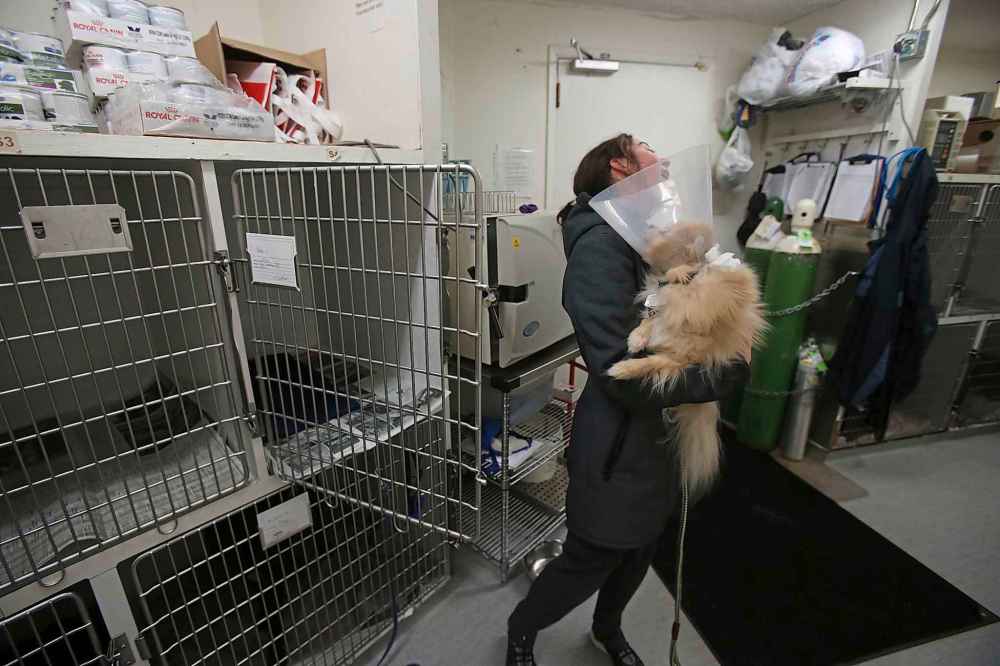
Toews, a receptionist and office assistant, is trying to get the patients fed and walked in a timely manner. She is repeatedly interrupted, however, by a jangly buzzer connected to the hospital’s front door — every buzz sends her rushing off to admit a new patient.
It’s the middle of December and Toews is one of seven staff members on shift tonight. She’s also one of the hospital’s newest hires, having recently completed a veterinary office assistant diploma program. She’s still getting used to working in emergency medicine.
“It scared me at first, but now I think I prefer it,” Toews says. “It’s the variety that happens during the emergency side of it. If you can handle it, you’re helping people who are in crisis sometimes, (and) that’s really rewarding.”
Dealing with animals and humans in distress has been the hardest part of the job so far.
“I’m a bit of a softie and sometimes people come in and they’re really sad, so you just have to be able to not always take things to heart and be there for people, but also not take it home with you,” she says. “I just need to remember that… as long as (the animals) are here, they’re getting care.”
After several minutes spent trying to convince the Pomeranian to eat, Toews moves on to her next task: laundry.
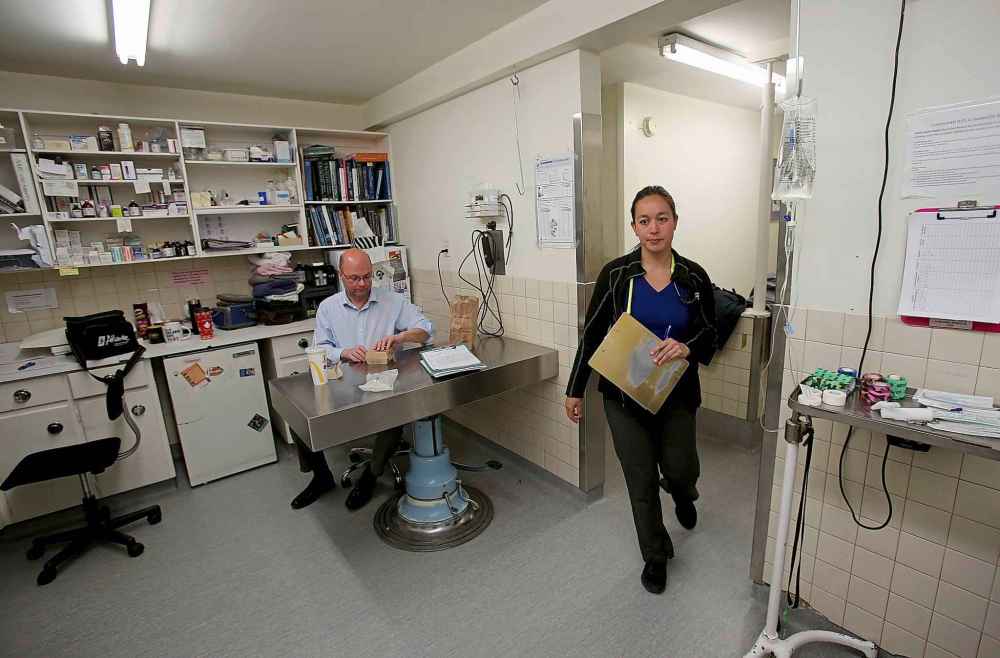
“If you didn’t get peed on, it wasn’t a good night,” she announces cheerfully, picking up a pile of blankets that includes her winter jacket.
In a small, dark room down the hall, Dr. Chelsea Lim is performing an ultrasound on an elderly black dog. The animal is sedated and lying on its back while Lim makes slow, clockwise circles with the scanning device on its abdomen. The veterinarian is trying to get a better look at the mass that showed up on the dog’s X-ray.
“Unfortunately, with ultrasounds, a lot of what I’m doing is looking for cancer,” she says.
Lim grew up in Singapore and studied veterinary medicine at the University of Sydney in Australia, but animals weren’t her first intended patients.
“Halfway through my pre-med degree I realized that if I went into med school it would mean years of working my way up a ladder to get to do anything that I wanted to do,” Lim says. “Doctors, they specialize a little bit more… whereas vets have more of a broad perspective.

“(My) day is a lot more varied than it would’ve been as a doctor.”
That’s especially true in an emergency vet clinic.
Tonight, there are ultrasounds, X-rays and surgeries scheduled, as well as whatever comes through the door — and what usually comes through the door during overnight hours are animals with serious injuries or worrying symptoms that can’t wait until Monday.
Some of the common ailments include excessive vomiting or diarrhea, traumatic injuries and ingested objects, says Lim.
The week marijuana was legalized in Canada in 2018, the clinic saw an uptick in dogs that had gotten into their owner’s stash.
“I think we see more edibles than we used to,” Lim says. “To be honest, we saw a lot of marijuana ingestion, period, beforehand… I find we get people admitting to it more now.

“We would never call the police or anything like that; we just want to know what’s wrong with the dog.”
Dogs suffering marijuana toxicity are put on an IV drip to flush the substance from their system, and their heart rate and temperature are closely monitored. The canines are usually able to go home in 12 to 24 hours.
The majority of patients are dogs and cats, but the hospital also takes in injured or sick wild animals for the Prairie Wildlife Rehabilitation Centre. In her six years at the clinic, Lim has cared for rabbits, owls, bald eagles, raptors, salamanders, a muskrat and a baby beaver.
She wraps up the ultrasound on the elderly dog and calls the owners to tell them on what she’s found: the animal has an adrenal mass that would require surgery from a specialist to treat.
Almost as soon as she hangs up, a small white dog is carried into the clinic in a laundry hamper. It’s in rough shape and appears to be having trouble breathing.
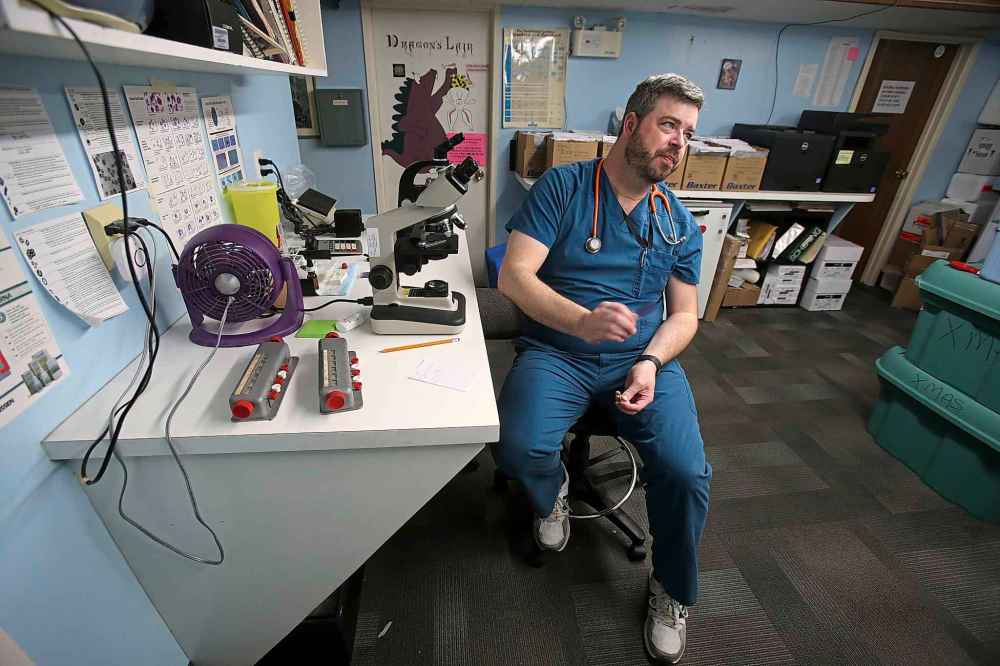
The dog is placed in an oxygenated kennel and Lim does a primary assessment, taking note of the animal’s yellowed gums — a possible sign of liver failure.
Registered veterinary technologist Steve Brown takes a blood sample and heads into the clinic’s basement lab. The small room is filled with boxes of files and expensive-looking equipment.
Brown has worked at the emergency hospital for 13 years and has seen a lot of staff turnover in his career.
“I was told at one point that the average tech’s job span is about five years,” says Brown, who describes his role as a nurse to the veterinarians. “(It’s) very high stress because you don’t know what you’re doing every day — you’ve got critical patients walking in, you’ve got clients in very stressful situations.”
He tries not to take his work home with him, but sometimes that’s not possible. Brown has adopted a total of four former patients, all stray cats who were brought in by the public.
“It snowballed,” he says. “I don’t think there’s a single staff member that hasn’t taken a pet home from here; we all want to see them get the best home.”
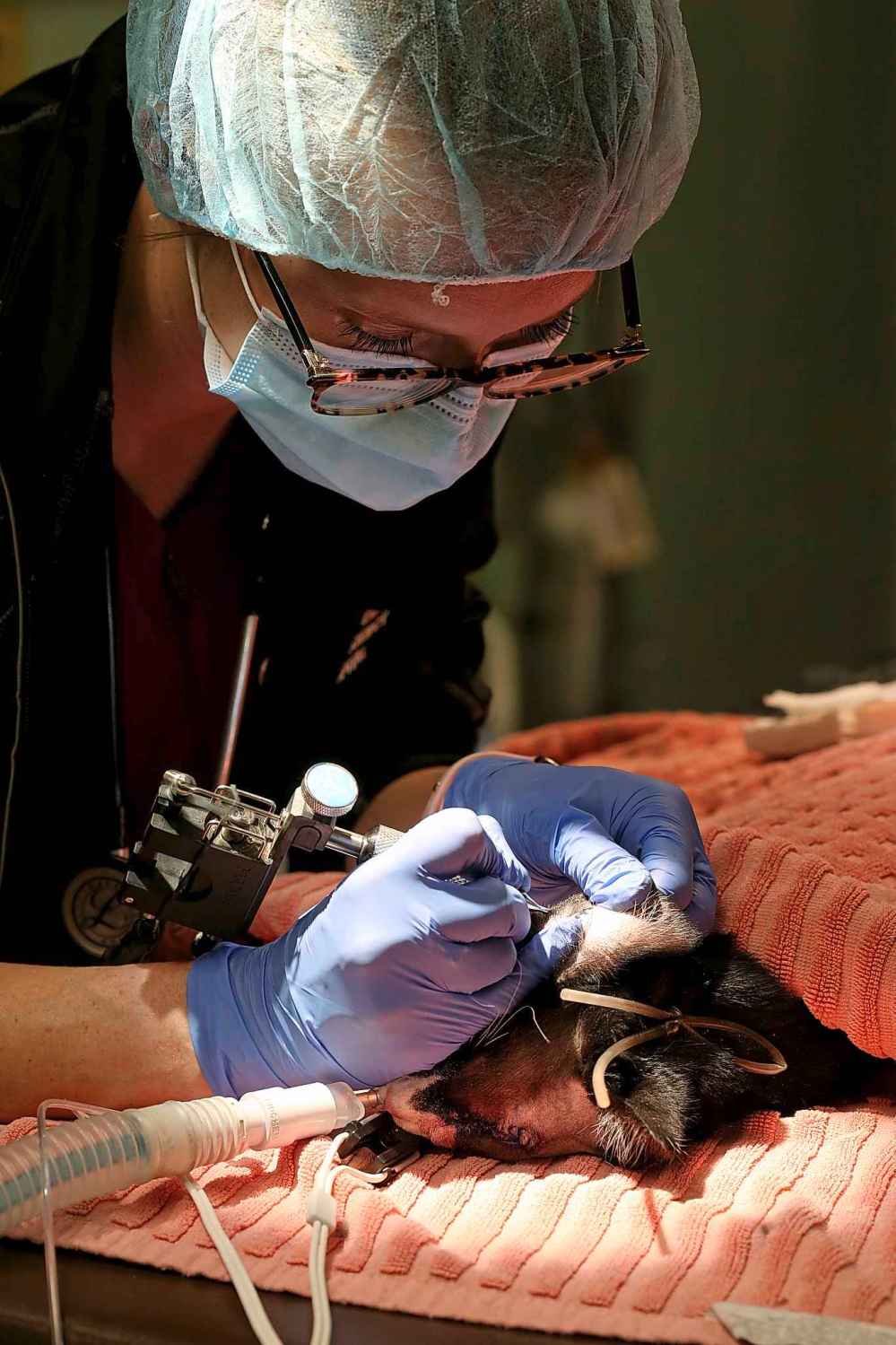
The bloodwork and chemistry tests for the small white dog aren’t looking good. The tests reveal there are enzymes in the blood that confirm issues with the liver.
Upstairs in the hospital’s surgical suite, veterinarian Dr. David Scammell is prepping a dog named Peaches for surgery. This is the second surgery she has had on her hind leg in the last month, after being hit by a car. Scammell is replacing and reinforcing a stainless-steel plate in the dog’s leg that has snapped in half.
“It’s always tougher going in the second time because sometimes the landmarks get obscured,” he says, unwrapping sterilized equipment that resembles woodworking tools, but is much more expensive.
As he works, delicately cutting into the dog’s leg and unscrewing the old plate from its bone, Scammell talks about one of the biggest challenges in veterinary medicine: money.
The Winnipeg Animal Emergency Hospital shares its clinic with the Pembina Veterinary Hospital during regular hours. Both charge $75 for exam fees until midnight, but the price tag is often higher for emergency services because more diagnostic work is usually required and staffing is more expensive on nights, weekends and holidays.
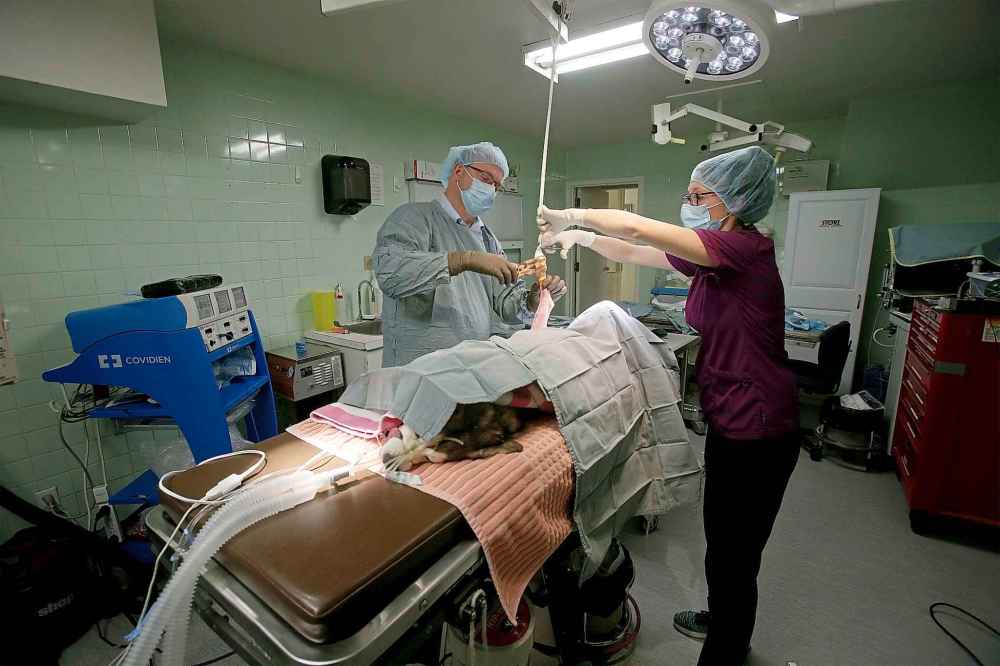
“Unfortunately we have to charge and not everyone can afford it,” he says. “That’s what causes me the most stress.”
Money often comes into play when an owner is tasked with making the difficult decision about euthanasia, which Scammell says is the most common procedure at the clinic.
“I’ve got a client right now that’s struggling to decide whether to euthanize and it’s exhausting,” he says. “Who do I advocate for? Am I advocating for the patient or for the owner? And for me, it’s always the patient, but sometimes the owners have a hard time letting go.
“We get attached to our family members.”
Lim agrees. It’s just a few hours into her shift and she’s already talked to two families about euthanasia as a possible treatment route.
“I don’t ever push it unless I think the animal is really suffering or if they can’t afford the treatment when the animal is really sick,” she says. “I don’t want them to go thousands of dollars in debt and end up with a dog that doesn’t survive.”
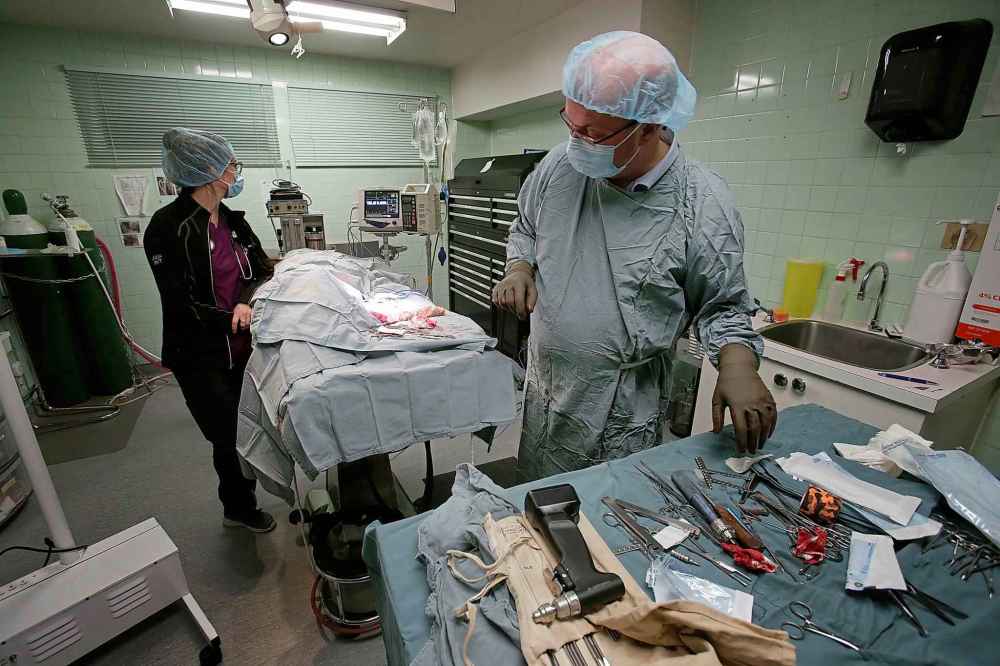
Boxing Day is often one of the busiest days for euthanasia at the clinic. Owners who want to spend one last Christmas with their beloved pets will postpone the inevitable until the holiday is over.
Sometimes the clinic will get the Winnipeg Humane Society involved if an owner is foregoing euthanasia at the expense of the animal’s welfare — although Lim says that’s the exception, not the rule.
“We try really hard to work with the owners to come to a conclusion that’s going to benefit everybody, because you don’t want anybody to feel forced into anything, especially euthanasia, which is a really difficult decision.”
When it comes to the procedure, Lim aims to be sympathetic and straightforward, explaining that once the dose of pentobarbital, an anesthetic agent, is injected, the animal will fall asleep and its heart will stop within 30 seconds to a minute. It’s a procedure she performed tonight on the elderly black dog with the adrenal mass.
“The owners came in and decided to euthanize the dog; adrenal masses are really difficult and risky surgeries,” she says. “She was quite an old dog, so I get their decision — it makes a lot of sense.”
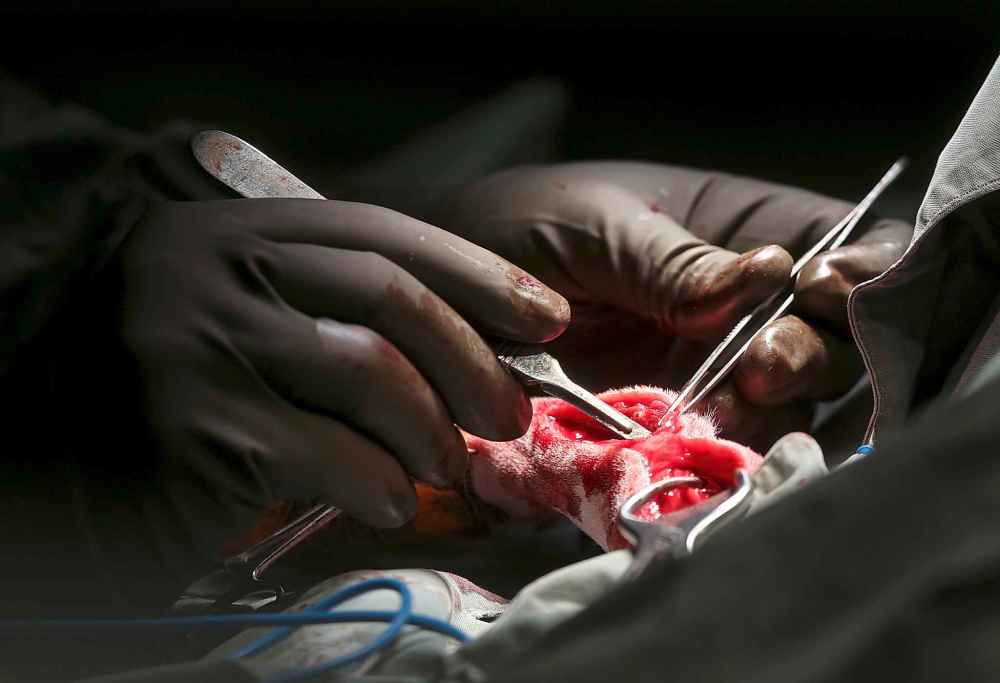
eva.wasney@freepress.mb.ca
Twitter: @evawasney

Our newsroom depends on a growing audience of readers to power our journalism. If you are not a paid reader, please consider becoming a subscriber.
Our newsroom depends on its audience of readers to power our journalism. Thank you for your support.










